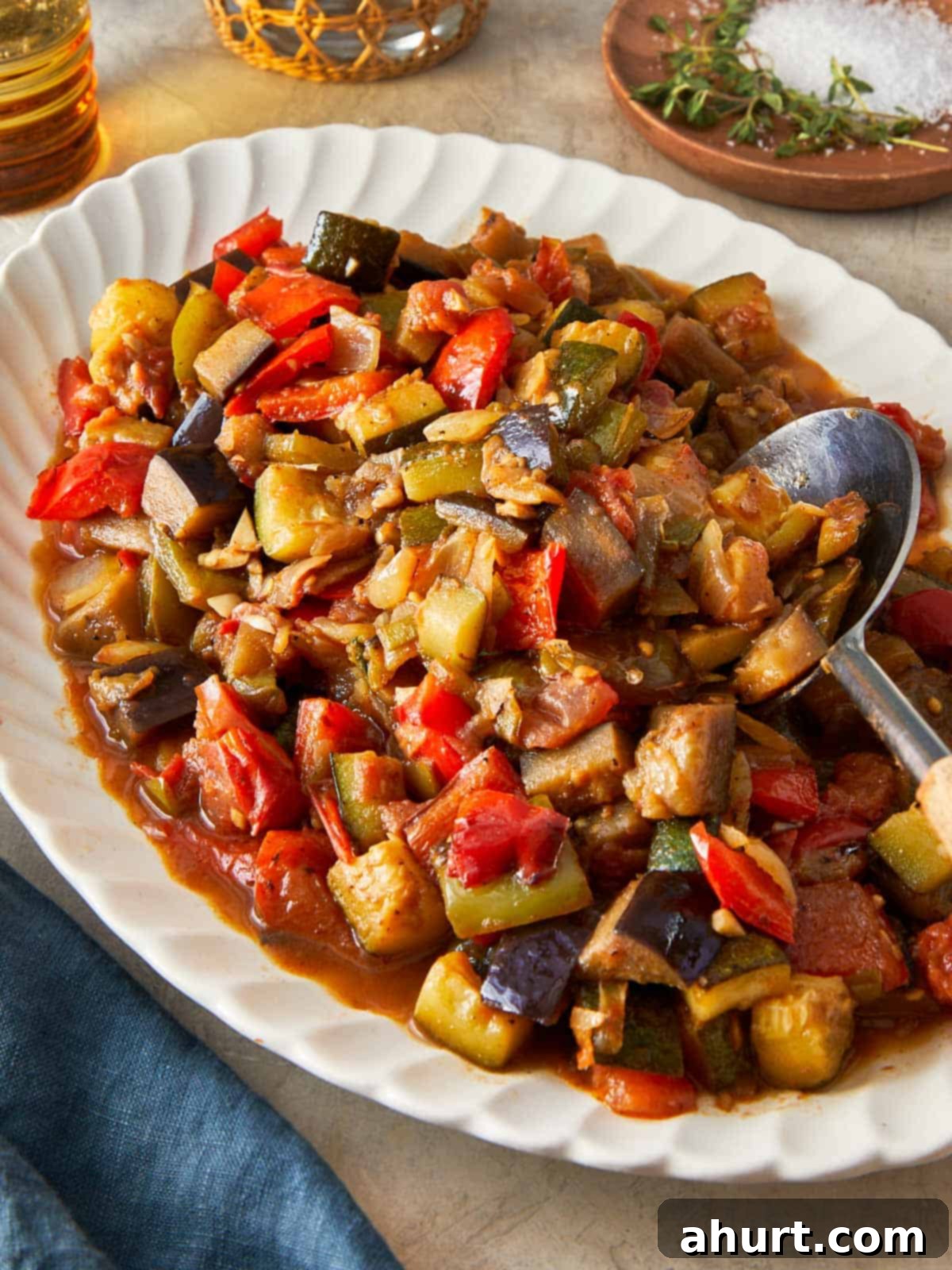Easy Ratatouille Recipe: A Classic French Vegetable Stew for Ultimate Comfort
Welcome to my ultimate guide for creating the most delicious and easy ratatouille recipe, a vibrant French vegetable stew that’s as comforting as it is elegant. This isn’t just any ratatouille; it’s a celebration of fresh, seasonal vegetables brought together in a harmonious blend of flavors and textures. Each spoonful offers a rustic charm that feels both cozy and sophisticated, making it the perfect dish for a quiet evening or a lively gathering. It’s the kind of recipe that encourages you to slow down, savor the process, and truly enjoy the simple pleasure of good food shared around a table.
With its delightful French accent, this classic dish is utterly irresistible. Just as the culinary master Chef Gusteau wisely proclaimed, “Anyone can cook!”—and this straightforward easy ratatouille proves that gourmet-level flavors are achievable in your home kitchen, regardless of your cooking expertise. Prepare to fill your home with the most incredible aromas and your plate with a taste of Provence.
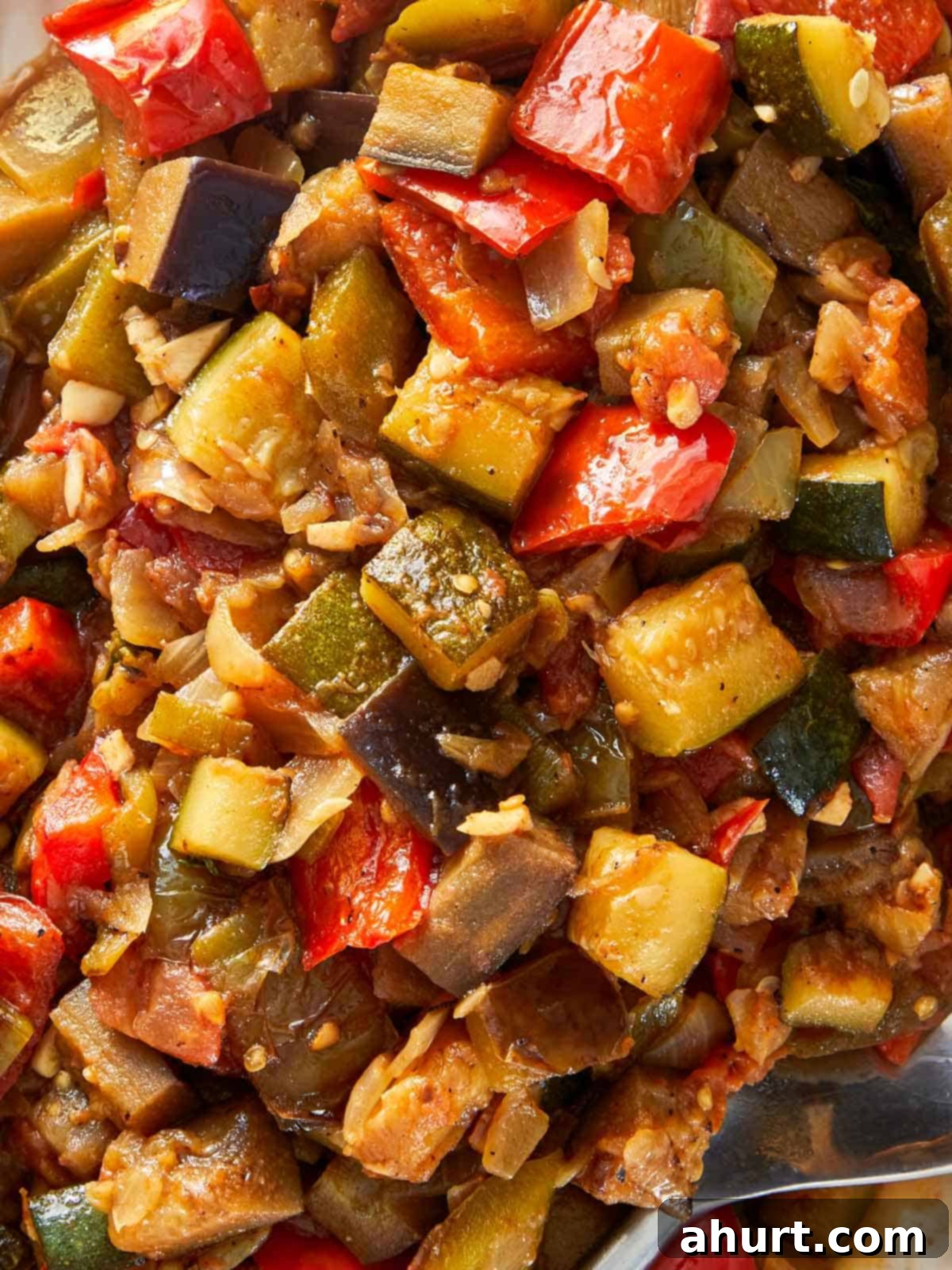
The Secret to a Truly Outstanding Easy Ratatouille (French Vegetable Stew)
There’s a reason this particular easy ratatouille or vegetable stew has become a perennial favorite in my kitchen. It’s more than just a dish; it’s a testament to how simple techniques can unlock extraordinary flavors. The core philosophy behind this recipe involves sautéing each vegetable separately, a method that might seem a little extra, but trust me, it’s where the magic happens. This individual attention ensures that each vegetable retains its distinct texture and develops a beautiful, caramelized exterior, rather than becoming a soggy mess when cooked all together. This layering of flavors is akin to the depth you find in my French Onion Soup, where every element contributes to a complex, satisfying profile.
After each vegetable has had its moment to shine, the pan is deglazed, capturing all those rich, golden, and sweet caramelised bits that are packed with flavor. These precious fond are then incorporated back into the stew, adding an incredible foundation to the dish. When all the carefully prepared ingredients finally come together to simmer gently, your kitchen will be enveloped in the intoxicating aroma of fresh herbs. Every bite of this rustic stew then reveals notes of natural sweetness from the bell peppers and tomatoes, a deep warmth from the garlic, and a subtle hint of spice that awakens the palate.
The true secret to an unforgettable ratatouille lies in cooking it low and slow. This gentle, unhurried process makes all the difference, allowing the individual flavors of the eggplant, zucchini, tomatoes, and bell peppers to melt into each other without losing their unique character. The result is a richly fragrant, deeply satisfying vegetarian stew that feels incredibly hearty and complete. It’s a dish that proves that a meat-free meal can be just as, if not more, gratifying than its carnivorous counterparts.
Beyond its incredible taste, this easy ratatouille is wonderfully versatile. You can serve it as the main event, perhaps with a generous slice of crusty bread to soak up every last bit of the flavorful sauce. Alternatively, it can play a magnificent supporting role alongside grilled proteins or a grain. I particularly adore pairing it with my Garlic Butter Asparagus with Crispy Parmesan. The crunchy, cheesy bite of the asparagus offers a delightful textural contrast and a burst of savory goodness that complements the tender, herbaceous vegetables of the ratatouille perfectly.
Bon Goût, Bon Cœur: Essential Ingredients for a Soulful Ratatouille
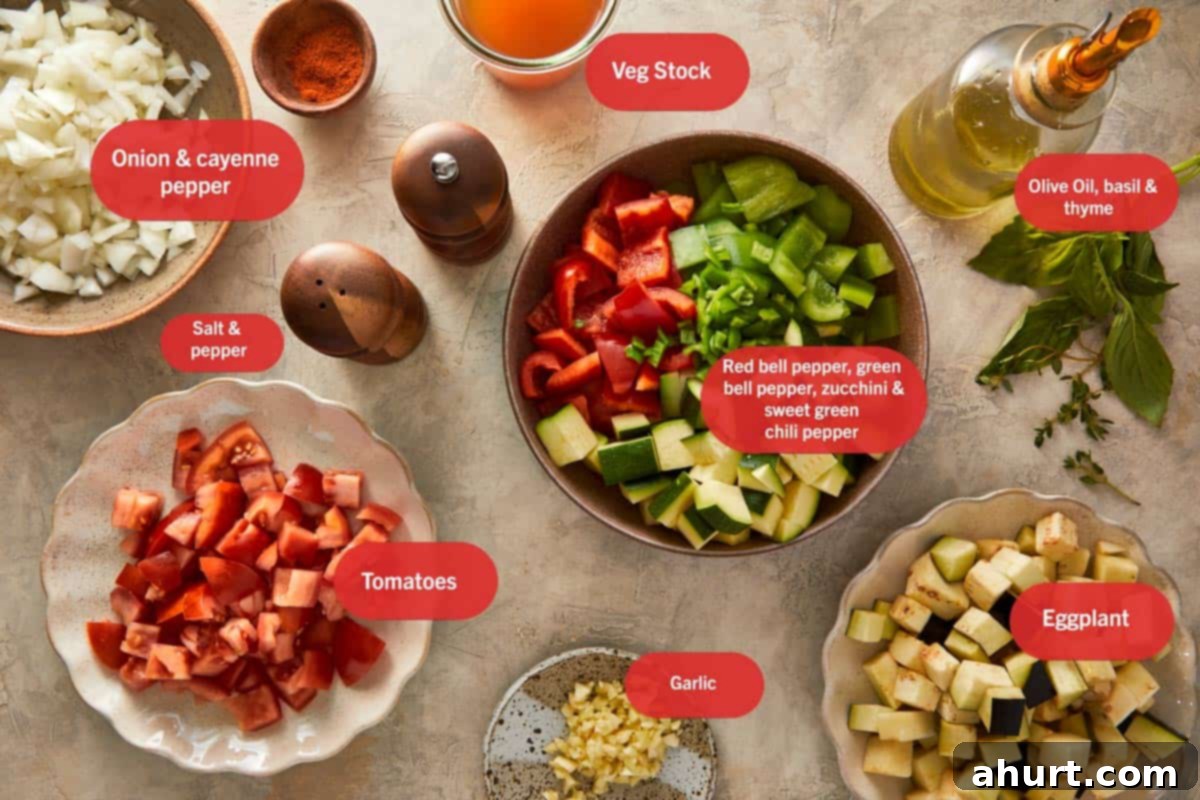
Every truly good easy ratatouille or vegetable stew begins with a handful of humble yet powerful ingredients that are absolutely essential. These fresh, vibrant stars are what give this dish its incredible body, soul, and the intoxicating aroma that makes it utterly unforgettable. Choosing high-quality, ripe produce is key to achieving the best flavor profile for your French vegetable stew.
- Eggplant: The backbone of ratatouille, eggplant transforms into a wonderfully silky and rich texture once cooked, soaking up all the beautiful flavors of the stew like a sponge. Look for firm, shiny eggplants without blemishes.
- Zucchini: Light, tender, and subtly sweet, zucchini brings a refreshing balance to the stew. It prevents the dish from becoming too heavy and adds a lovely succulence. Choose small to medium zucchini for the best flavor and texture.
- Tomatoes: The juicy, vibrant base that meticulously ties all the other vegetables together. Tomatoes add essential acidity, depth, and a subtle tang that brightens the entire dish. Fresh, ripe tomatoes are preferable, but good quality canned diced tomatoes can also work in a pinch.
- Bell Peppers: A mix of green and red bell peppers adds not only a burst of color but also a wonderful sweetness and a crisp-tender texture that holds up well during simmering. The green chili adds a very gentle kick, enhancing the overall warmth.
- Garlic & Onion: Boldly fragrant and aromatic, garlic and onion infuse the entire pot with a foundational warmth and savory depth that is truly indispensable for any good stew.
- Fresh Herbs: Thyme and basil are the quintessential French herbs for ratatouille. They contribute that iconic rustic French perfume that lingers delightfully in every single bite, elevating the dish from simply cooked vegetables to a true culinary experience. Always opt for fresh herbs over dried if possible, as their flavor is far more potent and vibrant.
- Olive Oil & Vegetable Stock: High-quality olive oil is crucial for sautéing and building flavor. Vegetable stock provides the liquid base for simmering and deglazing, enhancing the savory notes without overpowering the natural taste of the vegetables.
Note: For precise quantities and detailed measurements for this exquisite easy ratatouille, please refer to the comprehensive Recipe Card below.
How to Make the Perfect Easy Ratatouille: A Step-by-Step Guide
Crafting a classic like this easy ratatouille might sound daunting, but it genuinely comes down to a series of simple, straightforward steps. By following these instructions carefully, and letting the incredible aromas guide you, you’ll discover that oui, anyone can cook a truly perfect French vegetable stew. The key is patience and paying attention to each ingredient’s unique needs.
For a visual walkthrough of the entire process, including expert tips and tricks, make sure to check out the video in the See It In Action section for the full step-by-step demonstration.
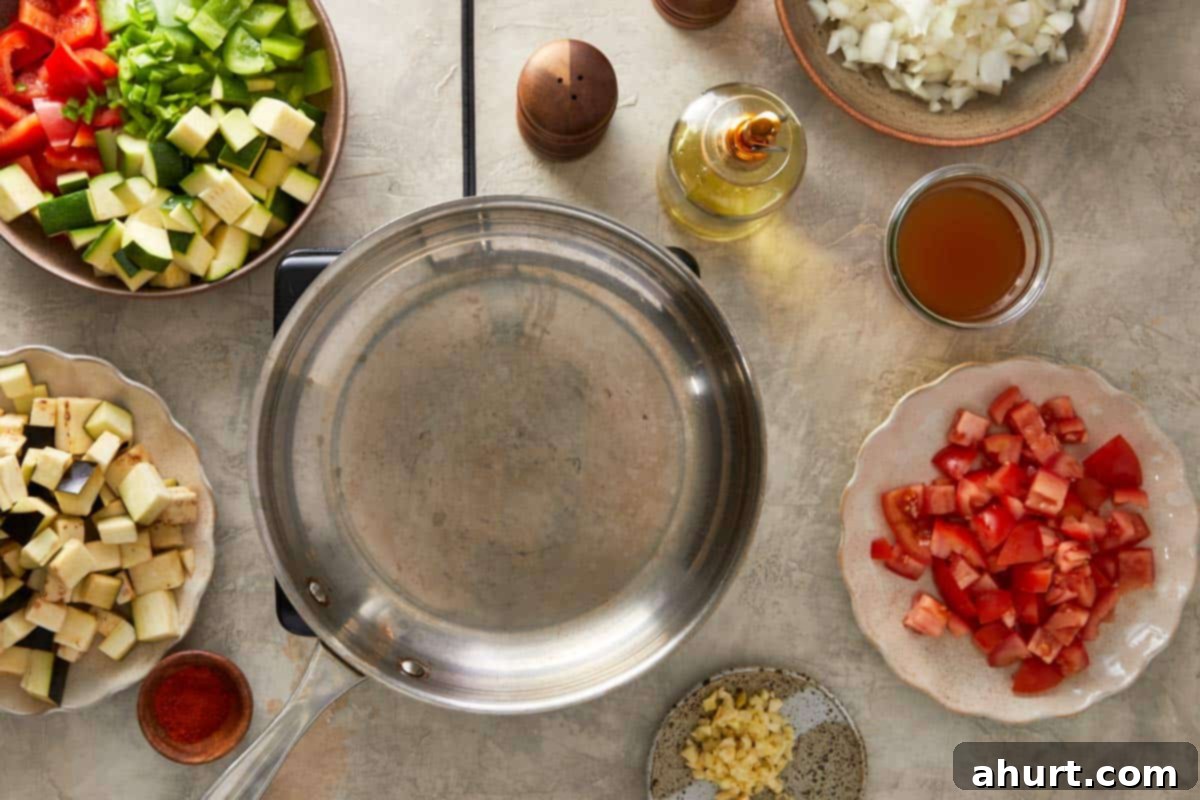
- Prepare Your Vegetables: Begin by washing all your fresh produce thoroughly. Dice the eggplant, zucchini, tomatoes, green chili, and bell peppers (remember to seed them first) into uniform ½-inch to ¾-inch (1.5 cm) pieces. Dice the onion into ¼-inch (0.5 cm) pieces, and mince the garlic cloves finely. Uniform sizing ensures even cooking and a beautiful presentation.
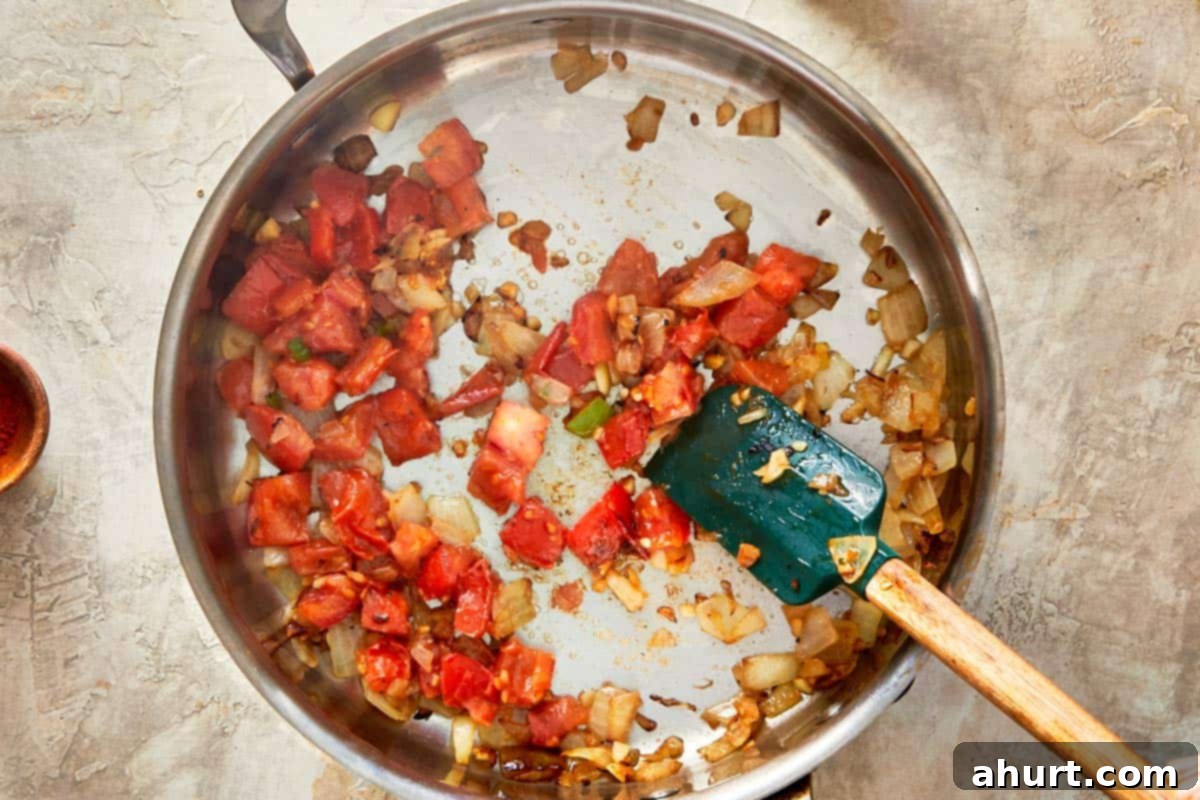
- Sauté Vegetables Separately: Heat about 1 tablespoon of olive oil in a large skillet or Dutch oven over medium-high heat. Start with the onions, cooking until they are soft and translucent (about 5-7 minutes). Add the minced garlic and cook for just one more minute until fragrant, being careful not to burn it. Remove the cooked onions and garlic and set them aside in a large bowl. Repeat this process for each vegetable individually (eggplant, then zucchini, then tomatoes, then bell peppers and chili), adding a fresh tablespoon of olive oil each time. Cook until each vegetable is golden and slightly tender-crisp. This step builds incredible layers of flavor.
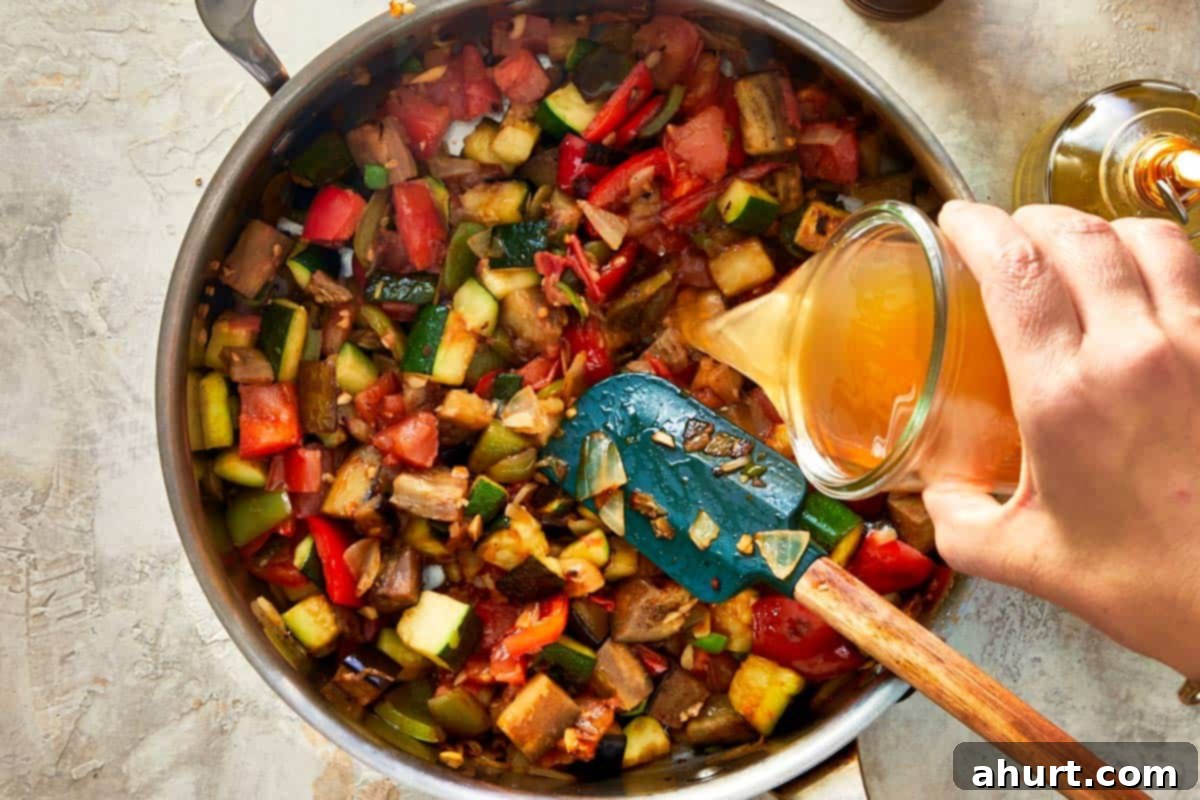
- Deglaze and Combine: Once all vegetables are sautéed and set aside, pour the vegetable stock into the same skillet or Dutch oven. Scrape up any browned bits (the “fond”) from the bottom of the pan with a wooden spoon – these are packed with flavor! Bring this liquid to a gentle simmer. Then, carefully return all the sautéed vegetables (onions, garlic, eggplant, zucchini, tomatoes, bell peppers, and chili) to the pot, ensuring they are evenly distributed.
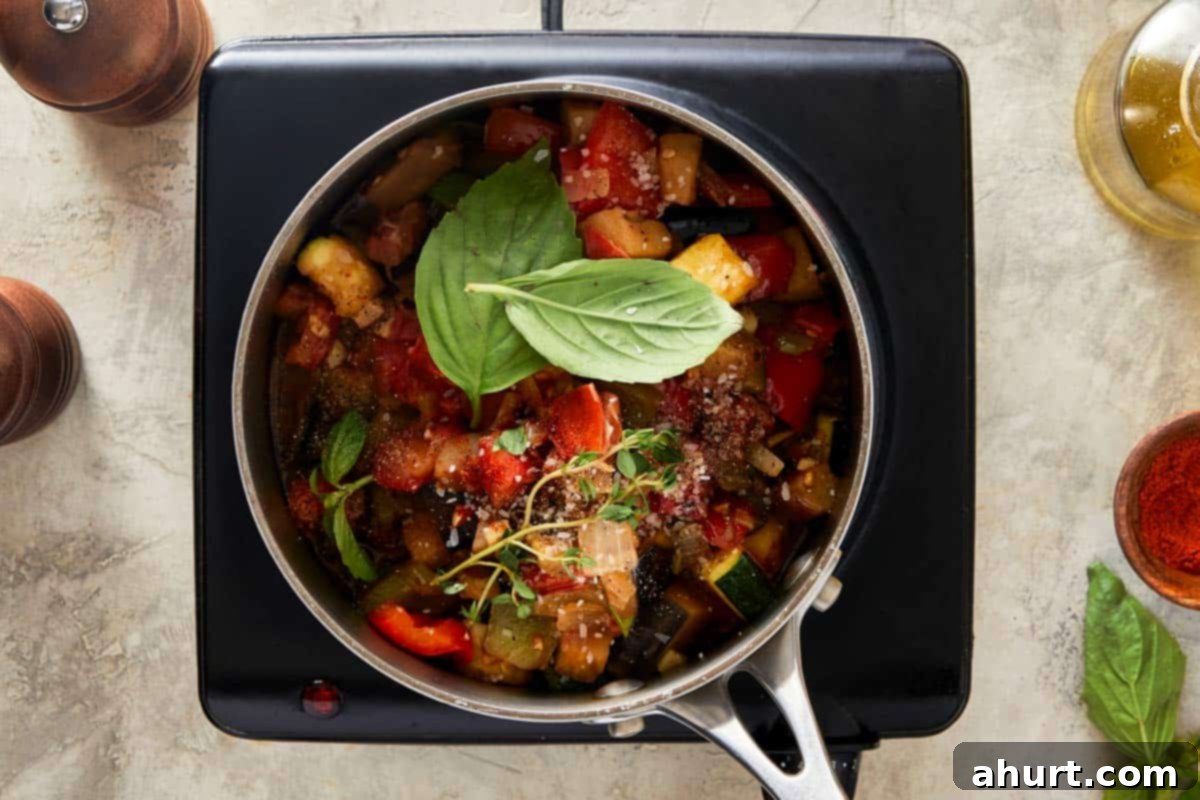
- Season with Herbs and Spices: Add the fresh thyme sprigs directly into the pot. Season generously with salt and freshly ground black pepper to taste. For a subtle warmth and a touch of excitement, add a pinch of cayenne pepper. Stir everything gently to combine, making sure the seasonings are evenly distributed throughout the vegetables.
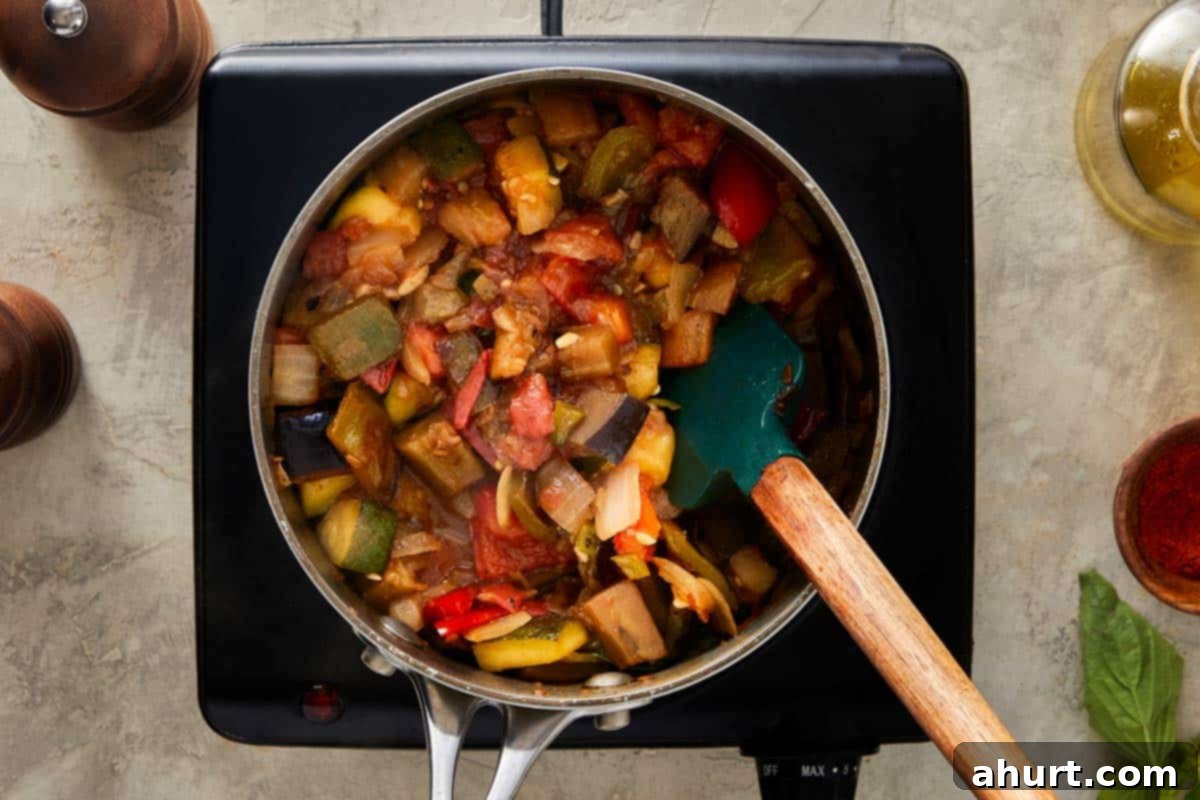
- Low and Slow Simmer: Reduce the heat to low, cover the pot, and let the ratatouille gently simmer for at least 20-30 minutes. This is the crucial stage where the flavors truly meld and deepen, transforming into a rich, cohesive stew. Stir occasionally to prevent sticking and ensure even cooking. The vegetables should become wonderfully tender but still hold their shape.
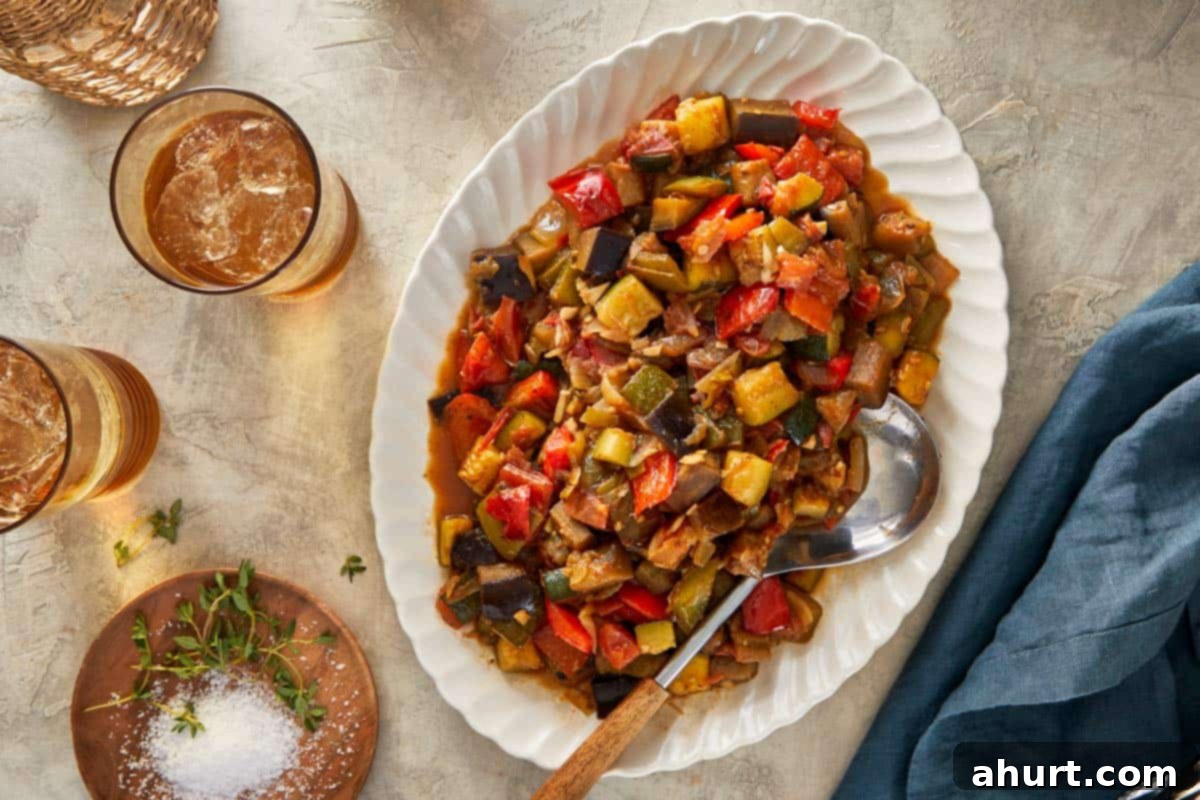
- Finish and Serve: Once the ratatouille has achieved its desired tenderness and flavor, turn off the heat. Carefully remove the thyme sprigs. Stir in the fresh basil leaves just before serving; their vibrant aroma and flavor are best when added at the very end. Taste and adjust the seasoning one last time, adding more salt, pepper, or cayenne if needed. Bring this warm and fragrant masterpiece to the table and prepare for compliments!
Pro Tips for the Best Easy Ratatouille
- Make it Ahead: Ratatouille is one of those magical dishes that often tastes even better the next day. The flavors continue to meld and deepen overnight. Store any leftovers in an airtight container and refrigerate for up to 4-5 days. Be aware that the vegetables will soften slightly more as they sit.
- Freeze for Later: For longer storage, allow the ratatouille to cool completely. Then, spoon it into freezer-safe containers or bags, ensuring it’s tightly sealed to prevent freezer burn. It will keep beautifully for up to three months. To serve, thaw it overnight in the refrigerator and gently reheat on the stovetop, in the microwave, or in a low oven until warmed through.
- Prep Smart: While the final cooking is best done in one go, you can prepare the sauce base or chop all your vegetables in advance (except eggplant, which oxidizes and browns quickly after slicing). This will significantly cut down on your active cooking time on the day you plan to serve.
- Healthy & Flexible: This easy ratatouille is naturally vegetarian, dairy-free, and gluten-free, making it a fantastic option for various dietary needs. It’s also incredibly nutritious, packed with fiber, potassium, and essential vitamins like A, C, and K. Feel free to adjust the seasoning to your preference or swap in other seasonal produce like yellow squash or different colored bell peppers. Ratatouille is wonderfully forgiving!
If this delightful easy ratatouille or French vegetable stew has ignited a craving for more comforting and flavorful dishes, you’re in luck! On days when I want to remain in that blissful French comfort zone, I often turn to my Coq Au Vin. This rustic chicken stew, bathed in rich red wine with bacon, mushrooms, and herbs, is both incredibly satisfying and surprisingly simple to prepare. For those bustling weeknights when time is of the essence, my Parmesan Crusted Salmon is a lifesaver. It goes from oven to table in under 15 minutes, delivering a perfect crispy, golden crust infused with garlic and Parmesan over tender, flaky fish.
When I have the luxury of a long simmer, nothing beats my Beef Bourguignon. Adapted from Julia Child’s classic, these tender chunks of beef cooked in a rich red wine gravy offer deep, complex flavors. Plus, it includes various cooking methods to fit your schedule. For a lighter yet satisfying crunch, my Oven-Fried Chicken with Honey Garlic Sauce is a healthier alternative to deep-fried chicken, without sacrificing any of the delicious crispiness. It’s an ideal choice for a wholesome family meal.
And to truly make any of these meals complete, I almost always whip up a batch of my Creamy Slow Cooker Mashed Potatoes. This versatile side dish stays unbelievably mega-creamy while using only half the usual butter, and it beautifully absorbs the savory flavors of garlic and Parmesan. It’s the perfect accompaniment to soak up all the delicious sauces from these hearty meals.
Frequently Asked Questions About Easy Ratatouille
Ratatouille is a quintessential classic French Provençal dish, specifically a stewed vegetable medley originating from Nice. At its heart, traditional recipes call for a slow simmer of ripe tomatoes, fragrant garlic, sweet onion, tender zucchini, silky eggplant, and vibrant bell peppers, all seasoned with aromatic fresh herbs like basil and thyme. The beauty of ratatouille lies in the way these simple garden vegetables transform into a rich, flavorful, and deeply comforting dish through gentle cooking. It’s a celebration of summer’s bounty and a testament to the power of simple ingredients.
Ratatouille is incredibly versatile and can be enjoyed in countless ways. It shines as a standalone vegetarian main course when served with a generous piece of crusty French bread, perfect for soaking up its delicious juices. It also makes an excellent side dish alongside grilled meats such as chicken, lamb, or steak, or with pan-seared fish. For a heartier meal, spoon it over fluffy rice, al dente pasta, or creamy mashed potatoes. Don’t forget its potential as a satisfying topping for toasted baguette slices (bruschetta style), baked potatoes, or even as a flavorful filling for omelets or savory crêpes. A dollop of fresh goat cheese or a sprinkle of Parmesan can elevate it even further.
Yes, traditionally, ratatouille is a vegetarian dish, made entirely from a medley of fresh vegetables, herbs, and olive oil. This means it is naturally vegan and also gluten-free, making it an ideal choice for a wide range of dietary preferences. The depth of flavor comes solely from the vegetables themselves and the slow cooking process, without the need for any animal products. Just ensure that if you’re serving it, no animal-derived toppings like cheese are added if catering to strict vegan diets.
Absolutely! Ratatouille is an excellent dish for meal prepping as its flavors often deepen and improve after a day or two. You can easily prepare it ahead of time and store it in an airtight container in the refrigerator for up to four days. For longer storage, ratatouille freezes beautifully. Once it has cooled completely, transfer it into freezer-safe containers or heavy-duty freezer bags. It will maintain its quality for up to three months. To serve, simply thaw it overnight in the refrigerator, then gently warm it on the stovetop over low heat, in the microwave, or in a preheated oven until it’s hot and delicious again. This makes it a perfect dish to have on hand for quick and healthy meals.
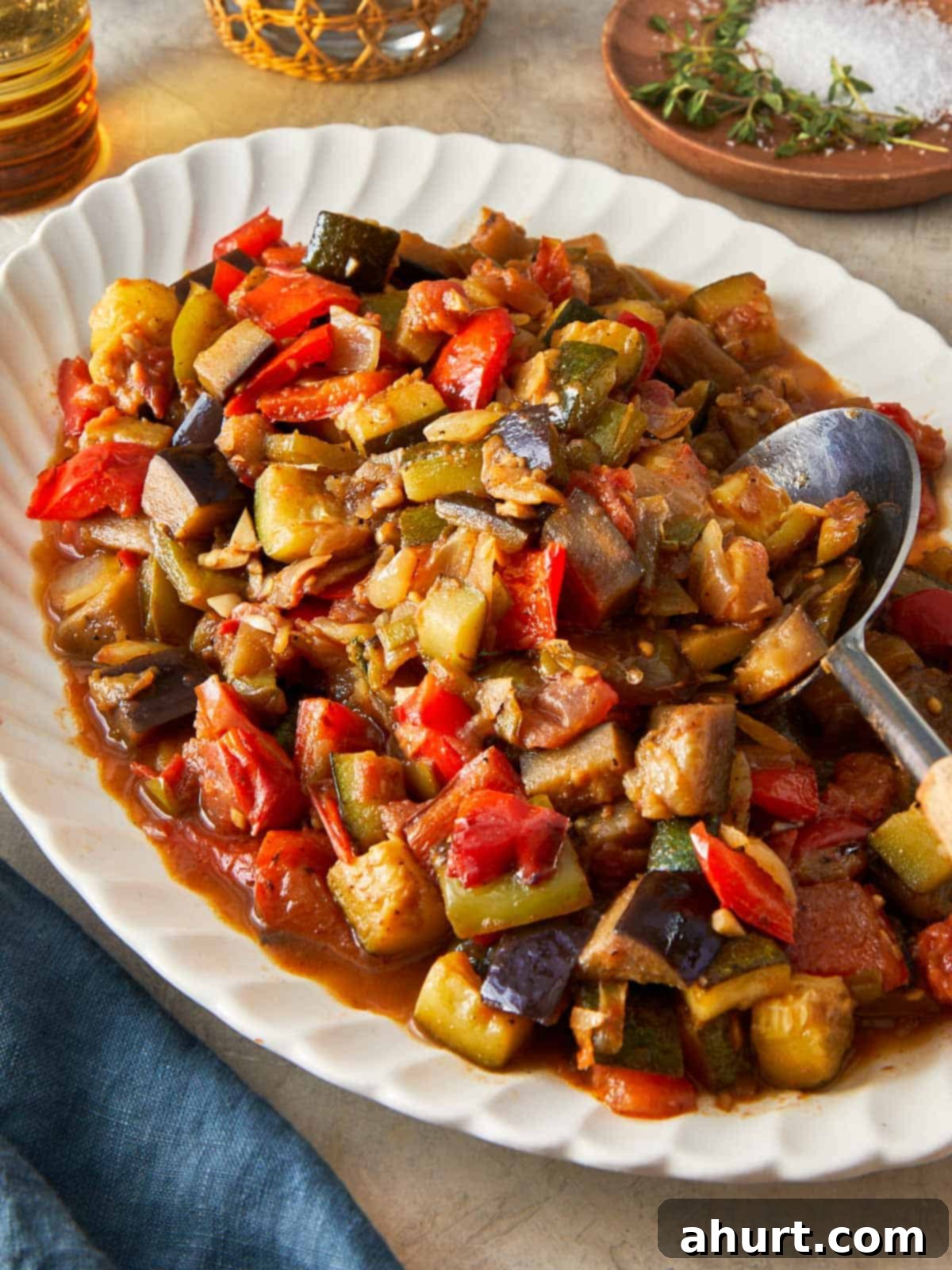
See It In Action: Step-By-Step Video Guide
Watch this video to see just how simple it is to bring this classic easy ratatouille to life in your own kitchen. From preparing the vegetables to the final simmering stage, every step is clearly demonstrated to ensure your success in creating a truly exceptional French vegetable stew.
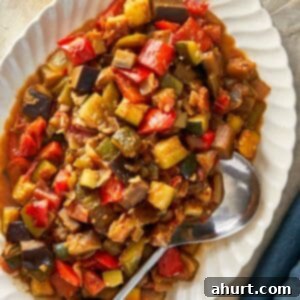
Pin
Easy Ratatouille Recipe (Classic French Vegetable Stew)
Ingredients
- 3 tbsp olive oil
- 1 onion diced ¼-inch (around 0.5 cm).
- 6 garlic cloves minced
- 2 tomatoes diced ½-inch to ¾-inch (1.5 cm)
- 1 eggplant diced ½-inch to ¾-inch (1.5 cm)
- 2 zucchini diced ½-inch to ¾-inch (1.5 cm)
- 1 green bell pepper seeded & diced ½-inch to ¾-inch (1.5 cm)
- 1 red bell pepper seeded & diced ½-inch to ¾-inch (1.5 cm)
- 1 sweet green chili pepper diced ½-inch to ¾-inch (1.5 cm)
- ⅔ cup vegetable stock
- 4 sprigs fresh thyme
- 10 basil leaves
- 1 pinch Salt to taste
- 1 pinch Pepper to taste
- 1 pinch Cayenne pepper to taste
Instructions
-
Heat about 1 tablespoon of olive oil in a large pot or Dutch oven over medium-high heat. Add the diced onions and cook until soft and translucent, which should take approximately 5-7 minutes. Stir in the minced garlic and cook for just one more minute until it becomes fragrant. Be careful not to let the garlic burn. Remove the cooked onions and garlic from the pot and set them aside in a large glass bowl.
-
Add another 1 tablespoon of fresh olive oil to the same pot. Add the diced eggplant and sauté until it turns golden brown on all sides and begins to soften. Remove the eggplant and add it to the bowl with the onions and garlic. Repeat this precise process separately for the zucchini, then the tomatoes, adding a small amount of olive oil each time as needed. Once cooked, add these vegetables to the same bowl with the rest of the sautéed ingredients. This separate cooking method is crucial for developing deep flavors and maintaining vegetable integrity.
-
Finally, add the remaining olive oil to the pot. Sauté the diced bell peppers and sweet green chili pepper until they are tender-crisp and slightly softened. Remove these and add them to the large bowl containing the other cooked vegetables.
-
Pour the vegetable stock into the now-empty pot or Dutch oven. Using a wooden spoon, gently scrape up any browned bits (the “fond”) that have stuck to the bottom of the pot. These flavorful bits will add immense depth to your ratatouille. Bring the mixture to a gentle simmer, allowing it to heat through.
-
Return all the previously cooked vegetables from your large bowl back into the pot with the simmering vegetable stock. Add the fresh thyme sprigs, season generously with salt and pepper, and add a pinch of cayenne pepper for a subtle warmth. Stir gently to ensure all the ingredients are well combined and coated with the seasonings.
-
Reduce the heat to its lowest setting. Cover the pot with a lid and let the ratatouille gently simmer for at least 20-30 minutes. This slow simmering period is essential for allowing the flavors to fully meld together and for the vegetables to become perfectly tender. Stir occasionally to prevent any sticking to the bottom of the pot.
-
Once the ratatouille is cooked to perfection, turn off the heat. Carefully remove the thyme sprigs from the stew. Just before serving, stir in the fresh basil leaves – their vibrant flavor and aroma are best preserved when added at the end. Taste the ratatouille and adjust the seasoning as needed. Serve warm and enjoy this incredibly flavorful French vegetable stew!
Notes
Every good cook has a few tricks up their sleeve. These are mine for getting the most out of this vegetable‑packed dish:
- Make it ahead: Ratatouille tastes even better the next day. Store leftovers in an airtight container and refrigerate for up to 4–5 days. Just note that the vegetables soften slightly as they sit.
- Freeze for later: Once cooled, spoon the stew into freezer‑safe containers. It will keep for up to three months. To serve, thaw in the refrigerator overnight and reheat gently in the microwave, oven, or on the stovetop.
- Prep smart: You can make the sauce and dressing ahead, but avoid slicing the eggplant until you’re ready to cook—eggplant oxidises and browns quickly.
- Healthy & flexible: This dish is naturally vegetarian, dairy‑free, and gluten‑free. It’s also rich in fibre, potassium and vitamins A, C and K. Feel free to adjust the seasoning and swap in seasonal produce; ratatouille is wonderfully forgiving.
Nutrition
Nutrition information is automatically calculated, so should only be used as an approximation.
